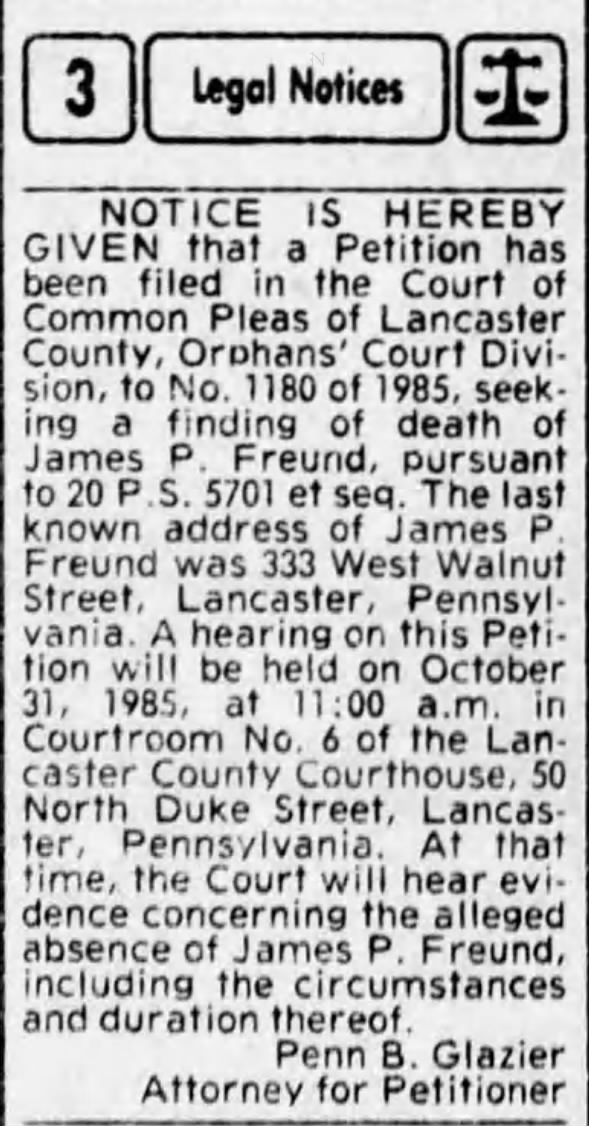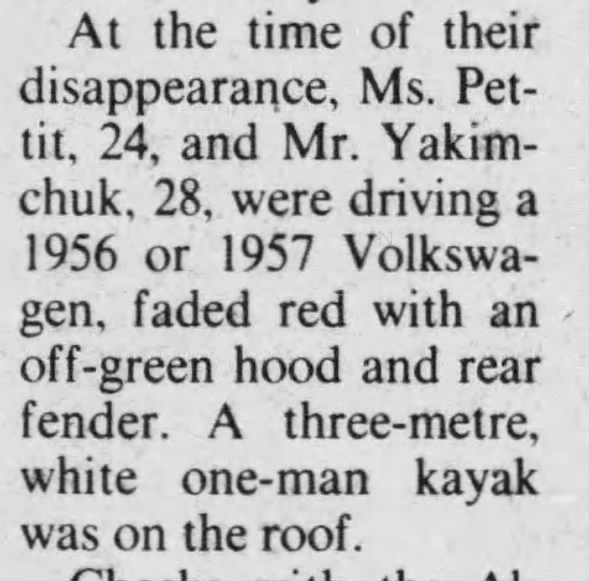Author: Shane Lambert
Original Time of Writing: January 21st, 2021
All articles are subject to editing after the original posting.
Missing person #1: Ronald Yakimchuk
Last-seen date: June 5th, 1973; might be June 1st, 1973
Last-seen location: Brandon, Manitoba
Last-contact: June 12th, 1973. A postcard from Dryden, Ontario (sent by wife)
Link to Government Source:
Canada's MissingEthnicity/Race: Caucasian
Sex: Male
Age at time of disappearance: 27
Hair: Brown
Eye color: Brown
Height and weight at the time of disappearance: 6'0" and 150 pounds, which would look very lean
Missing person #2: Theresa Yakimchuk
Alias: Terry Pettit (Terry is a derivative of Theresa, Pettit is likely the maiden name)
Last-seen date: June 5th, 1973; might be June 1st, 1973
Last-seen location: Brandon, Manitoba
Last-contact: A postcard from Dryden, Ontario (June 12th, 1973)
Link to Government Source:
Canada's MissingEthnicity/Race: Caucasian
Sex: Female
Age at time of disappearance: 23
Hair: Blonde
Eye color: Blue
Height and weight at the time of disappearance: 5'4" and 121 pounds
Ronald and Theresa Yakimchuk were from Edmonton, Alberta. They traveled east in the spring of 1973 using a "faded red" Volkswagen Beetle "with an off-green hood and rear fender." This vehicle also had a three-meter-long and white kayak affixed to the top of it.
Mon, Jun 9, 1980 – 4 · Edmonton Journal (Edmonton, Alberta, Canada) · Newspapers.comThere is some inconsistency between the historical journalism that covered this case and modern government database information. The vehicle in question might be anywhere from 1956 to 1959 (plate: Alberta, CA3-262). The picture below is the last one taken of the missing couple and it shows their vehicle as well.
The missing people were traveling to Montreal to attend a wedding. However, they never made it to that wedding.
The date of the wedding that they were planning on attending was called "mid-June" in an article in the June 9th, 1980 edition of The Edmonton Journal. Another source says the exact date of the wedding was June 16th, 1973 (Nov 17 2007 Edmonton Journal). They sent a postcard on June 12th, 1973 from a town called Dryden, Ontario.
Search Area or Incident Location: Disappearance Event Focus, Dryden to Montreal
Presumptively, something happened to them between Dryden and Montreal between the dates June 12th and June 16th. In fact, the area between Dryden and Ottawa is more probable.
The couple visited someone known as "an associate" in Brandon, Manitoba. I believe that this visitation might be the last physical sighting of them.
Furthermore, Canada's Missing says they went missing on June 1st but some journalism on this matter says they left Edmonton on June 5th, 1973. If that is true and if they visited associates in Brandon, Manitoba, then you would have to think they were last seen on at least June 7th, 1973, as the drive from Edmonton to Brandon is not one that most drivers would complete in a day.
Complicating this case is the lack of clarity regarding the missing couple's travel plans. While they did want to attend a wedding, they "planned to travel indefinitely after that." A news piece on
this missing couple from 2023 stated that they were planning to start a new life in the Maritimes.
The family did not start to worry about their well-being until a few months after they were last seen. Furthermore, the police didn't help with this case until seven months after they went missing, as per the source below.
Mon, Jun 9, 1980 – 4 · Edmonton Journal (Edmonton, Alberta, Canada) · Newspapers.comUnredeemed Cash Draft Should Be Considered a Huge Clue as to Whereabouts
One important detail, in this case, has to do with a banking matter. Terry Pettit (ie. Theresa Yakimchuk) purchased a "cash draft" from her bank account in Edmonton and, from what I'm gleaning from the journalism, she planned to redeem it in Ottawa. However, this was not done.
For that reason, I would limit the focus area to in-between Dryden and Ottawa. They sent the postcard from Dryden so they were there. If they made it to Ottawa, it stands to reason that Theresa would have cashed the bank draft.
Monetary assets are rarely treated in a frivolous matter. In my opinion, when something like a cash draft, money order, paycheque, or personal check goes uncashed in a missing person's case, it should always be considered extremely relevant. For that reason, I do not think they made it to Ottawa.
I think a "cash draft" might be called a "money order" in more modern lingo. Back then, I think it would have been called a cashier's cheque or a bank draft. It's like a cash that cannot bounce because the funds for it are already guaranteed, much like a loaded VISA debit card in contemporary times.
Ottawa, as a potential destination, is important in this case. One early report having to do with this case said the missing people had friends there. These friends never met the couple that summer (Edmonton Journal Jan 22 1974).
Mon, Jun 9, 1980 – 4 · Edmonton Journal (Edmonton, Alberta, Canada) · Newspapers.comCouple Considered Dead as of 1980
The opinion of family and police on this matter, in 1980, was that the Yakimchuks had somehow died.
Leads have not been numerous, but in 2007 it was reported that someone claimed to have seen them in July 1973. According to this person, she and her husband saw the Yakimchuks highway-side near Parry Sound, Ontario in what would have been late-July of 1973.
The witness described a Volkswagen Beetle, a man that looked like Ronald, a woman that looked like Theresa, a third man, and Alberta license plates.
This sighting did not make a lot of sense to me for a few reasons. I think something happened to them between June 12th and June 16th, 1973. So the late-July 1973 sighting does not make a lot of sense. Also, a route through Parry Sound would not be the most efficient one between Dryden and Ottawa. Lastly, a 34-year gap between the sighting and the reporting date leaves some questions about the person's memory. As per the description below, the kayak on the roof is missing, which simply suggests that it's a different vehicle and different people.
Sat, Nov 17, 2007 – 3 · Edmonton Journal (Edmonton, Alberta, Canada) · Newspapers.comNote: in the article above, "CFB Shilo" would be a Canadian military base near Brandon, Manitoba.
Even with Alberta plates, the area around the Great Lakes in Ontario is popular enough for tourism that it would not be surprising to see plates from any part of Canada, especially during the summer months.
If the kayak had been on the vehicle, then that would have been a much more convincing sighting. I wouldn't discount this sighting, but it is not convincing to me. It's something that those who are interested in this case need to be familiar with. But my feeling is that something else needs to align with this alleged sighting before it can be taken too seriously.
Remember, the missing people did not make their wedding target in Montreal for June 16th. They sent no communications after the Dryden postcard. Furthermore, Theresa did not redeem her cash draft in Ottawa. I still think that a highway mishap befell this couple somewhere between Dryden and Ottawa.
Dryden Location Means They Had Plenty of Time to Get to Montreal
These were 20-somethings who seemed to be interested in growth via travel at a young point in their lives. They might have explored the back areas of Ontario -- not just the main tourist spots near the main highways. If they were in Dryden on June 12th, then they were close enough to Montreal that they had a few days of free time before the wedding.
That their vehicle has never been found is a major point in this case. However, I did read one article from 1980 that suggested that their vehicle had been found. I did not find a follow-up article to this.
Tue, Jun 17, 1980 – 54 · The Gazette (Montreal, Quebec, Canada) · Newspapers.com
Car Not Found, People Still Missing
There are lots of missing persons cases where the vehicle is found but the driver and passengers remain missing. It seems that finding a vehicle is a lot easier than finding the primary subjects of searches. In fact, "car found person missing" is one of the most common tags on this website.
That the Yakimchuks' vehicle has never been found could mean that the vehicle went missing with the passengers. This is something that has happened numerous times.
One case that this reminded me of is
the missing-person case of Janet Farris. In 1992, she was driving from Vancouver Island
to a wedding in Alberta. Like the Yakimchuks, she never made the wedding. She was never heard from again and nor was her car ever found -- until 201,9 when it was pulled out of a lake in the Revelstoke area.
Notable Cases of Missing Persons Found Submerged with Their Vehicles
| Name | Disappearance Date | Last Known Location | Car Details | Discovery Date | Submersion Location |
|---|
| Janet Farris | August 1992 | Vancouver Island, BC, Canada | 1969 Plymouth Barracuda | August 2018 | Griffin Lake, BC, Canada |
| David Hannah | 1983 | Bath, Ontario, Canada | Unspecified car | May 2023 | Lake Ontario, near Amherstview |
| William Moldt | November 7, 1997 | Lantana, Florida, USA | White 1994 Toyota Celica | August 2019 | Pond near housing development |
| Donna Graves & Son | January 18, 2013 | Ottawa, Ontario, Canada | Dodge Dart | January 20, 2013 | Ottawa River, Ottawa, Canada
Reported: CBC News |
| Larry Anderson | 2004 | Murray, Utah, USA | Leased car (make unspecified) | February 2025 | Flaming Gorge Reservoir, Utah
Reported: CBS News |
- Janet Farris: Confirmed as a 1969 Plymouth Barracuda, per CBC reporting referenced in your blog.
- David Hannah: Car details aren’t widely specified in public reports (e.g., Kingston-area news); it’s simply noted as "his car."
- William Moldt: Identified as a white 1994 Toyota Celica in police and news accounts from 2019.
- Donna Graves: Reported as a Dodge Dart in Ottawa police statements from 2013.
- Larry Anderson: Described as a leased car in Utah news, with no make or model detailed in early 2025 reports.
Missing people in their vehicles are sometimes found in roadside bushes. But Ontario is well known for having thousands of lakes. It can be hard to picture a car going off of the highway and ending up in a deep part of a lake as you might picture the shallow depths stopping the car's momentum. However, cars can go off highways and submerge at significant enough depth to be hidden for decades.
One officer who worked on this case seemed to think that the car and the missing people may have entered Lake Superior -- at least, he acknowledged the possibility. I align my own hunches with his.
I would think Lake Superior and any other water not far off the main route between Dryden and Ottawa would be part of the search area. Unfortunately, the area is so immense that the manpower is not likely to be afforded to cover all the possible areas.
Sat, Nov 17, 2007 – 3 · Edmonton Journal (Edmonton, Alberta, Canada) · Newspapers.com But make no mistake -- this
is a case that Websleuths and amateur investigators can help with.
There was a case in 2019 that was solved when a Google Earth user found a submerged car using that software. The car was located in a small body of water, not far from shore, and inside the car was a missing person who had been there for decades.
Many rivers might have submerged a car that was driven off of a bridge. However, if everyone who reads this took ten minutes to use Google Earth to search the shallow depths of lakes and rivers that come close to highways, then it might yield results in the long run. I don't know what color the car would be now, but maybe a kayak might still be affixed to the top -- maybe not. That's the direction I think this search should go in when it comes to amateur contributions.
If you are researching this case, then it may be fruitful to use "Ron Yakimchuk" or "Terry Pettit" as your keywords. Those are the names that turned up hits in the newspaper archives that I looked at.
Other details:
- Their car was not in good condition
- Lt. Col Sid Stephen was the last person to see them near Brandon, Manitoba
- He warned them about dangerous stretches en route to Montreal
- Someone found what appears to be a VW Beetle buried in their backyard; it will be interesting if leads develop (see the Websleuths forum)
Prediction: They Will Be Found
I don't think there's a police budget in Ontario big enough to search every highway-side body of water. But my prediction for this case is that they will be found by a random citizen or dedicated volunteer because these people aren't on the clock. Fishermen, swimmers/divers with new underwater technology, or magnet fishers are all the kinds of people who might find a submerged vehicle, whether while looking for it or accidentally.
Timeline of Ronald and Theresa Yakimchuk’s Disappearance
| Date | Event |
|---|
| Early Spring 1973 | Ronald and Theresa plan a trip east from Edmonton, Alberta, in their VW Beetle. |
| June 1st, 1973 | Official disappearance date per Canada’s Missing (RCMP); contested, may be a June 5th departure. |
| June 5th, 1973 | Depart Edmonton, per journalism. |
| June 5th–7th, 1973 | Last seen in Brandon, Manitoba, by Lt. Col. Sid Stephen; he warned them about dangerous routes. |
| June 12th, 1973 | Theresa sends postcard from Dryden, Ontario (last contact). |
| June 12th–16th, 1973 | Disappear between Dryden and Ottawa; miss Montreal wedding on June 16th. |
| June 16th, 1973 | Wedding date in Montreal they fail to attend. |
| Late July 1973 | Unverified sighting of a similar VW Beetle near Parry Sound, Ontario (no kayak). |
| Late 1973 | Family begins worrying after months of no contact. |
| January 1974 | Police investigation begins, seven months after disappearance. |
| 1980 | Family and police presume couple dead; unconfirmed report suggests vehicle found. |

































.jpg)


.jpg)
.jpg)

.jpg)



